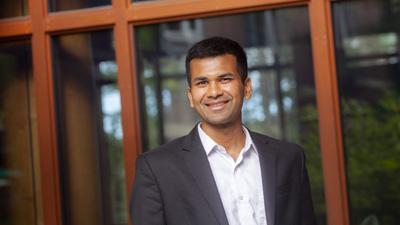Better Decisions Through Science // Analytics and Digital Operations
With uncertainty at an all-time high, the operations and management science faculty, along with Tuck's international trade economists, are helping a range of industries refine their practice and prepare for what might come next. In this multi-part feature, we highlight current research by Tuck faculty.

Focus // Analytics and Digital Operations

Lauren Lu
Associate Professor of Business Administration, Daniel R. Revers T’89 Faculty Fellow
The Challenge
Using IoT Data to Understand Consumer Behavior
The rise of e-commerce has brought a revolution of convenience and competition to consumers, allowing people to shop from home while enjoying low prices. E-commerce has also been a boon to retailers, in part because they can see and analyze their customers’ online shopping behavior and use it to set prices and promotions, and predict trends. But with all the attention paid to e-commerce, it’s easy to forget that a vast majority of retail sales still come from transactions at brick-and-mortar outlets.
Tracking consumers in the physical world is much harder than doing it in the digital one, but new technologies and methods are shrinking that gap. Tuck associate professor Lauren Lu has been studying these developments and learning how retailers can use data from various sources to understand consumer behavior and make better operational decisions.
In a new working paper, Lu examines how retailers are using data from radio-frequency identification (RFID) technology—an IoT tool—along with field experiments to inform outreach to customers. The paper reports on a collaboration with a technology startup that uses digital customer engagement strategies to help retailers communicate with their customers. In particular, Lu studied a national car wash chain that sells monthly subscriptions to customers at its car wash facilities. The customers attach an RFID tag to their car to gain entry to car wash facilities, which also allows the retailer to know how often and where the customer is using the service.
Collaborating with the car wash chain, the startup did a field experiment, sending car wash reminders via email to customers, and tracking which customers responded to the emails and used the service. When Lu analyzed the data, she learned that it’s not always beneficial to send engagement emails to customers. “The key tradeoff is, these emails help retain customers, but if you keep reminding customers of the service, they will constantly use it, and that will increase operating costs,” Lu explains.
With that in mind, Lu used the data to understand which customer segments should receive engagement emails, depending on their subscription level and prior usage patterns. “We show in the paper that this car wash chain can improve its profit by more than 10 percent if they use a selective email engagement strategy, rather than a blanket strategy,” Lu says.
Incidentally, the technologies and methodologies Lu discusses in her paper will be part of her new spring elective, Data-Driven Analytics for Innovative Operating Models.

Raghav Singal
Assistant Professor of Business Administration
The Challenge
Pay On-Demand Drivers a Fair Wage
More than five million drivers serve on platforms such as Uber and Lyft. In big markets such as New York City, most of them work “full-time,” hoping to make a decent living by driving alone. It hasn’t been easy. Many of them invested in their career by getting a loan to buy a vehicle, only to be “turned off” by the app during the non-peak hours of the day. The result is a day spent “at work”—ready to drive customers—but just a few hours of paid time. Many are not making enough money to cover their car payments and have a livable wage. “There are drivers who spend eight or so hours on the road but on paper they are paid for a fraction of that time,” says Raghav Singal, an assistant professor of business administration who specializes in analytics and revenue management applications in e-commerce. This has been a problem not only for the drivers, but for Uber and Lyft as well, who have struggled to recruit enough drivers to meet the overwhelming demand for ride-sharing services. Because of this shortage, the cost of a ride from these companies has increased by 92 percent between January 2018 and July 2021, and customers are experiencing increased wait times.
If you are smart about accommodating drivers’ preferences, you can have decent performance guarantees on how much profit you can reap from the system.
Singal and a few colleagues are working on a solution. Thus far, most ride-sharing companies have allocated drivers primarily according to the prevailing demand from customers, with little consideration of when drivers want to be working. In a working paper, Singal created a model that captures the individual driver preferences (regarding when to drive) and combines it with a rider-side model that seeks to have the most drivers on the road during peak times (e.g., morning and evening rush hours) without having too many on-road drivers during non-peak hours. Moreover, it mediates those inputs to maximize profit for the platform. “We show that if you are smart about accommodating drivers’ preferences, you can have decent performance guarantees on how much profit you can reap from the system,” Singal says. “It’s kind of a win-win: you can increase drivers’ welfare without hurting platform profits.”
The Challenge
Using AI and IoT to Keep Industrial Assets Running
A key aspect of digital operations is the almost real-time and fine-grained marriage of the physical and digital worlds using technologies like the Internet of Things (IoT), AI, analytics, robotics, 3D printing and blockchain. There are myriad interesting intersections in this area, but for Brian Tomlin one of the most important is the use of IoT and AI technology to keep industrial assets running and generating revenue. Unplanned downtime in the energy, manufacturing, process, and transportation industries is a very big problem. When a natural gas plant is inoperable for a single day, it can cost $25 million. In aggregate, it has been estimated that unplanned downtime in the process industries equates to about five percent of annual global production, or $30 billion.
With the rise of IoT and AI, firms can deploy smart sensors and high-powered analytics to perform “condition-based monitoring” (CBM) of their machinery and equipment. “As sensors get cheaper, and AI gets more sophisticated,” says Tomlin, “you can have sensors taking a variety of readings—vibration, fluid contamination, temperature, etc.—and feed that data into proprietary algorithms that generate a condition health state of the asset, and then make predictions about when it might fail. That then enables predictive or preventive maintenance, so the machinery doesn’t have an unplanned outage.”
While CBM helps solve one problem, it also creates another: questions around the ownership and security of the sensor data. Is the sensor data owned by the original equipment manufacturer (OEM) that builds the asset and provides after-sales maintenance services, or by the customer firm that operates the asset? The law is unsettled on this point. It is an important question because the benefits of CBM may not fl ow equally to the OEM and the customer, and because data ownership gives one party control over whether CBM can be deployed. The challenges of data ownership and security will need to be addressed if IoT and advanced-analytics-based CBM is to realize its vast potential.
In a working paper on this topic, Tomlin and his co-author Cuihong Li found that CBM benefits the OEM and the overall after-sales supply chain, but it may not benefit the customer, especially when the customer can exert effort to improve the reliability of the asset. They propose and analyze a data-access fee in which the OEM pays the customer for the data to overcome the customer’s reluctance to enable CBM. Such a fee can, however, have a ripple effect on the relationship between the parties and on how the manufacturer designs the machinery. “One implication of the research is that CBM might make asset leasing more attractive, because it aligns incentives and removes the question of who owns the data,” Tomlin says.